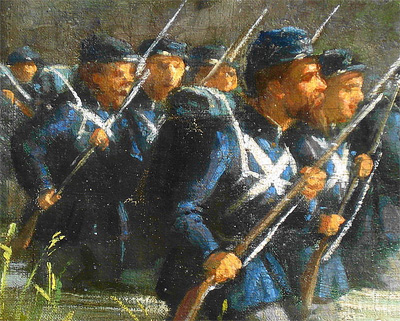Manner & Technique: Introduction to Homer's Manner of Painting

Introduction to Homer's Manner of Painting
The manner in which Homer applied paint to the canvas clearly accounts for the âunfinishedâ criticism he received for the first 20 years of his career as an artist. Homer was mostly a self taught artist, having taken all of four oil paint lessons from a fellow artist, Frederic Rondel, in 1861 (3.1). Relying on his own practice at his new found occupation as oil painter he took more than a year to finish his first painting, Sharpshooter 1863; ⌠whereas the painting was finally signed and datedâpresumably at its completion as much as a year laterâat the lower left (3.2).
 Fig 3-1: Homer was dedicated to laying down un-modulated
Fig 3-1: Homer was dedicated to laying down un-modulated color as suggested by Michel Eugene Chevereul.
Although Homerâs lack of training and newness to his profession may have contributed to his label of âunfinishedâ, it is more likely his dedication to techniques of laying down un-modulated areas of paint as suggested by Frenchman Michel Eugene Chevereul in his 1859 book titled, The Laws of Contrast and Color (Fig. 3-1). Chevereul was a chemist and was Director of Dyes for the Royal Manufactures at the Gobelins tapestry works beginning in 1824 (3.3). Homer received his copy of Chevereulâs book from his older brother Charles, also a chemist, in 1860 (3.4). Homer called it his âBibleâ (3.5). In his writings Chevereul discusses two approaches to the modeling of form: painting by chiaroscuro (forms developed by subtle gradations of shadow) and painting in flat tones (separate, un-modulated areas of color) (3.6). It was in Homerâs time, and always had been, standard painting practice to smooth two colors next to each other with the brush to blend and soften color edges producing a finished look. Nicolai Cikovsky, Jr. in his 1988 study of Homerâs civil war paintings says; The two most apparent and to his contemporaries most puzzling and objectionable traits of Homerâs art were the ârudeâ and âcoarseâ suggestiveness of its style and the seemingly incomplete, even fragmentary, form of its pictorial propositions. These traits were visible in all his art of the later 1860s and 1870s ⌠(3.7). Homerâs coarseness in painting was by choice. He carefully controlled his painting technique in all of his civil war paintings through his determined dedication to Chevereulâs ideas, leaving paint pigments unblended on the canvas. His unfinished look was therefore intentional, in spite of the criticism he received.
Watching the Shot clearly contains many examples of the laying of paint in an un-modulated technique. The soldiers crossing the river at first appearance seem to be wearing dark blue standard issue, one color uniforms. However, under a lens it is easy to see an array of colors depicting the varying ways in which sunlight creates shadows (Fig. 3-1). The colors laid beside each other and unblended consist of a violet hue, light blue, and an emerald green hue upon the darkened blue of the uniform. This lack of blending and the side by side layering of complementary colors are all ideas that come directly from Chevereulâs book. Homerâs unfettered dedication to Chevereulâs ideas, are found throughout Watching the Shot as well as all Homer paintings of the 1860s.
Watching the Shot. © 2026 All rights reserved. Terms of Use and Privacy Policy
